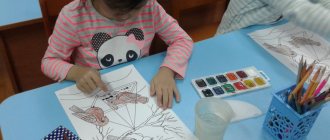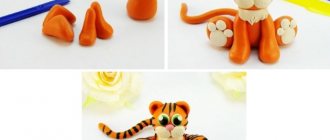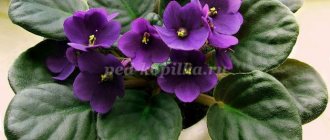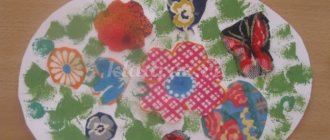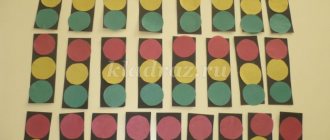Abstract on fine arts in the middle group “In the world of warm and cold colors”
(Children complete the task, commenting on their choice, hang the pictures in the appropriate order)
(In the work “The Seabed” blue, cyan, and violet paints are used. These colors are cold, which means the picture was painted by the artist Ldinka, he likes to paint with cold colors)
— Artist Ldinka, did the guys correctly identify your work? Whose answer did you like better?
Ice: That's right, that's my job. I paint with cold colors. I liked the answer the most...
(In the work “Chicks for a Walk” we see a lot of yellow and orange. These colors are warm, which means it was painted by the artist Ogonyok)
— Artist Ogonyok, do you agree with the guys’ choice? Is this your job? Whose answer did you like?
Ognyok: That's right, this is my job, I paint with warm colors. I liked the answer...
Etc.
- That's right, well done!
Fairy tale "Porcelain Factory"
Target:
develop children's creative abilities through decorative drawing.
“Children, in the country of Drawing, where Ogonyok and Ldinka live, there was a porcelain factory where they made very beautiful porcelain dishes.
(The teacher shows several porcelain cups, saucers, a teapot, a sugar bowl, etc.)
—
Look at the beautiful patterns the dishes are decorated with. Wouldn’t it be nice to drink tea from such a cup?
(Children look at dishes decorated with various patterns, express their opinions, choose their favorite patterns)
(The teacher summarizes the children’s reasoning, while paying attention to the various details of the patterns on the dishes (flowers, leaves, geometric elements) and the color combination of the patterns (cold or warm colors))
—
One day, the director of a porcelain factory invited the artists Ogonyok and Ldinka to his place and gave them an order: to paint a large batch of dishes with patterns. The artists agreed, but said that they definitely needed assistants. And the artists also reminded that one of them paints only with cold colors, and the other - only with warm ones.
—
Guys, do you agree to help the Artists with their work?
(Yes!)
(Artists Ogonyok and Ldinka recruit assistants. (All children are divided into two teams and sit in two working groups))
(The teacher gives the children blanks for creative work - white silhouettes of dishes pasted on colored cardboard. The first group (“Ice Artist”) receives blanks on cardboard in cool colors (blue, dark blue, violet; the second group (“Ogonyok Artist”) receives blanks on cardboard in warm colors (yellow, orange, blue))
- Children, you must now paint your sample of dishes with a pattern, while not forgetting that the work should be done either only in cold or only in warm colors (in accordance with the color of the cardboard).
Summary of an integrated lesson on drawing and ecology for children in the middle group of kindergarten.
Summary of the drawing lesson “Flower - seven-colored”.
Author: Kokorina Tatyana Nikolaevna, teacher of additional education in drawing, MBDOU No. 202 general developmental kindergarten, Kemerovo. Description: this lesson will be interesting to teachers of primary and secondary groups, mothers who like to draw with their children. Purpose: conducting a lesson according to the theme of the week. Goal: studying the structure of a flower, learning how to draw a flower sequentially. Objectives: - introduce children to the structure of a flower: root, stem, leaves, inflorescence - core and petals; - remember and consolidate the name of a group of flowers, depending on the place of growth (in the meadow - meadow, in the field - field, etc.); — learn to draw a flower sequentially; - contribute to the development of the child’s active vocabulary; - promote the development of fine motor skills through drawing; - cultivate interest in the surrounding nature; - cultivate the desire to draw a beautiful picture. Necessary tools and materials: - half a landscape sheet; - colour pencils.
Introductory part. The lesson begins on the street, this could be the beginning of a walk. Children with a teacher approach a flower bed. Educator - Guys, look at what beautiful flowers grow in our garden flowerbed. Which ones do you know? Children - Marigolds, asters, peonies, etc. Educator - Well done, that’s right, there are these flowers here. What are the names of all the flowers that grow in the garden? Children - Garden Teacher - Where else can flowers grow? Children - In the forest, in the clearing, in the meadows. Educator - That's right. What are the flowers growing in the meadow? Children - Meadow. Educator - And on the field? Children - Field. Educator - And in the forest? Children - Forest. Educator - Let's repeat, in the garden - garden, in the field - field, in the meadow - meadow, in the forest - forest. Children repeat after the teacher. Main part. Educator - Let's look at this flower. Let's get acquainted with its structure. The flower has a stem on which leaves grow. At the top of the stem there is an inflorescence - a flower. A flower has a core from which petals grow, they are located around the core. An unopened flower is called a bud. Repeating the structure with several children, using different colors as an example. Educator - Do the flowers have the same inflorescences? Or do they have differences? Children - there are big and small Educator - They say a large flower, a small flower. That's right, they differ in size. And look at the leaves. What kind of leaves does this flower have? Children are narrow and long. Educator - Yes, you can also add elongated ones, and say narrow-leaved ones. Repeat with me. Children repeat. Educator - What kind of leaves does this flower have? Children - Large, round. Educator - What different garden flowers we have! They have the same structure, but they are different in the size of the inflorescence and the shape of the leaves. Each flower is attractive, unusual and delicate in its own way. Now listen to the poem: Our flowerbed is a sight for sore eyes! Admire her! Lifts the mood of everyone who approaches her. How many fragrant flowers there are here! How many delicate petals: Silky and fluffy. Thin, flexible stems. How many colors fit! You just can’t take your eyes off it! It’s as if a rainbow came down to paint flowers for us... ...We won’t pick flowers And we’re in a hurry to tell others: Let them bring joy to people, To everyone - both the little ones and the big ones! Children with teachers go for a walk. Returning from a walk, they find a magic chest in the group. Educator - Look, while we were away we got a magic chest, I wonder what’s in it? Let's open it quickly. It's a flower! Yes, how unusual! Children, what kind of flower is this? Children – Magical, colorful, etc. Educator - This is probably a flower from a fairy tale. Does anyone know which one? Children - “Flower - seven flowers.” Educator - That's right. Why is seven a flower? Children - Because there are seven petals. Educator - Seven petals, seven flowers. How about what? Children - At the Rainbow. Teacher - Wonderful flower! What is its magic? Children - He granted wishes. Educator - Let's see if it looks like an ordinary flower. Is everything in its structure? Children and their teacher look at the flower, remember and name its parts. Educator - Although this is a wonderful, magical, fairy-tale flower, with a completely unusual color, its structure is the same as that of any flower. Let's draw a flower - a seven-flowered one! Children - Let's go! Educator - Then let’s go to the tables and draw a flower. Practical work. Educator - Let's start drawing from the ground, because a flower, like any plant, grows from the ground. 1.Take a brown pencil and draw a line to mark the ground, hillock or flowerbed. Lightly press the pencil to paint.
2. Now take the green and paint on top of the brown, thus adding grass on top of the ground.
3.Using a green pencil, draw the stem of the flower, leaving space at the top for the inflorescence.
4. Let's move on to drawing the inflorescence. First, of course, we draw a round core; for this we take a pencil of a delicate beige shade.
5.Now we draw the petals. Which one should we start with? What is the first color in the rainbow? Children - from red. Draw the first red petal.
6.Now which one? That's right, orange and yellow
8.Behind them is green.
9.Then – blue and blue
11.And the inflorescence is completed by a purple petal.
The flower inflorescence is ready. 12.Draw the leaves. And the flower is ready.
Now add the sun and the sky so that the flower is warm. You can also add a cloud with rain, because a flower needs to drink. Here is such a beautiful flower - we have created a seven-flowered flower! Now let’s hang all your flowers on the board and we’ll have a whole flower meadow and admire them. Well done guys, you did a great job! Several children's works.
We recommend watching:
Application for the senior group on the topic “Bullfinches on branches” Development of spatial thinking in 6-year-old children Non-traditional drawing techniques in kindergarten. Space Summary of GCD in the middle group “Let's help the birds in winter”
Similar articles:
Summary of a comprehensive lesson on familiarization with the outside world and development of speech “Wintering Birds” in the senior group of a preschool educational institution
Lesson notes for the GPD. Cuttings of indoor plants

